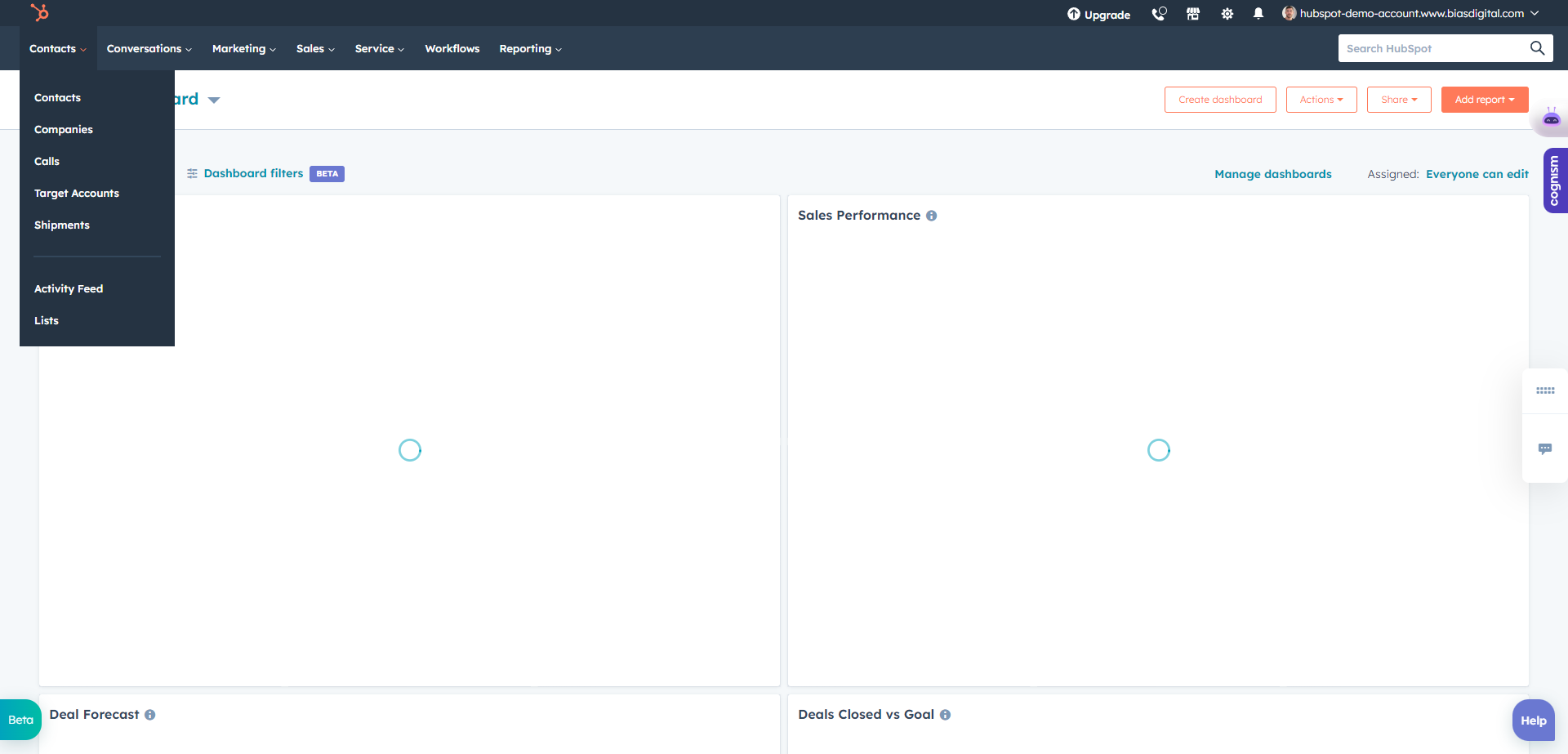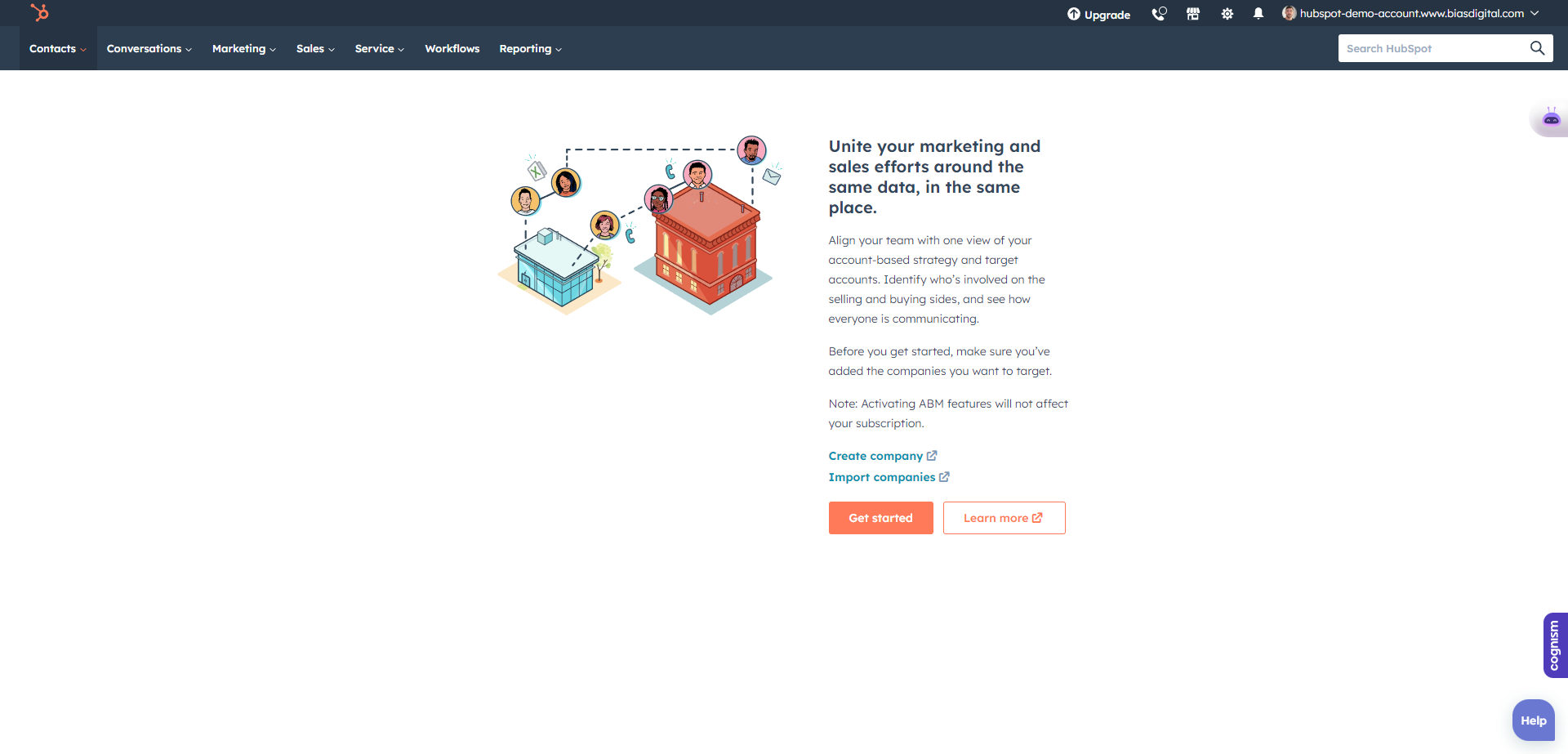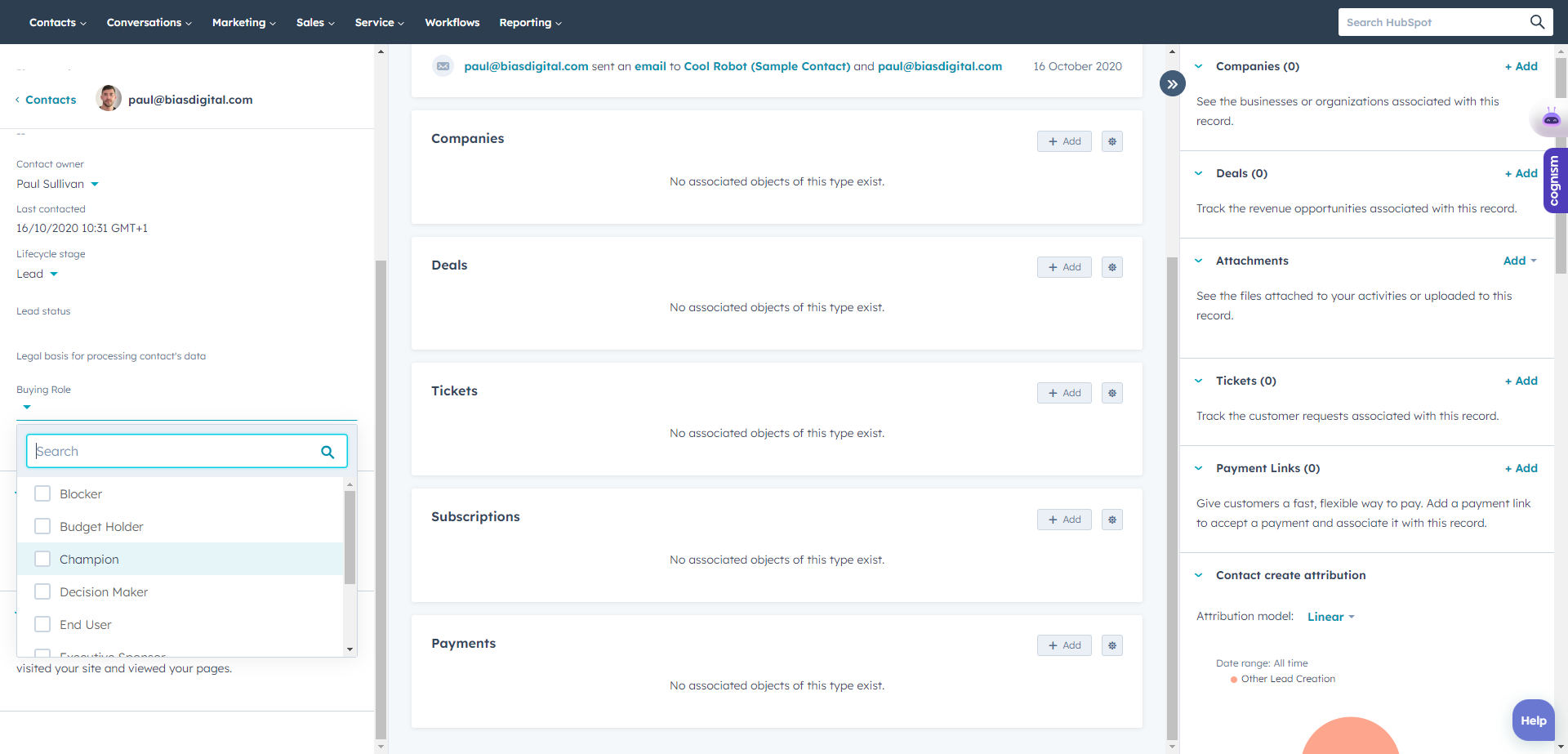Account-based marketing (ABM) is the hot topic for 2023, and it's only getting hotter for 2024. As more SaaS and Fintech products come to market with a product offering that serves the broader and enterprise markets, blended ABM, a strategy we specialise in at BIAS, is now becoming the strategy of choice.
There are two versions of blended ABM; one is ABM + Demand Generation, which serves a purpose for less mature tech that doesn’t fully understand its audience yet and relies on broader features, benefits and pain point-led messaging.
Our AMPLIFY© product with a blended ABM approach suits a more mature or focused approach where every account is named, and you employ all versions of ABM: One-to-One, One-to-Few and One-to-Many.
Five Solid ABM Tactics for HubSpot Users
Given that I’ve lept straight into ABM tactics here, let’s jump into my five solid tactics for users on HubSpot, starting with HubSpot.
#1 Account-Based Marketing on HubSpot
For those not in the know, you need to switch your HubSpot to Company view, not Contact view. In ABM, we focus on the Company first and then the Contacts afterwards. Open the Contacts drop-down menu, and you’ll see Target Accounts at the bottom of the menu.

Click here and follow the prompts to set up the workflow to activate your target account reporting and management.

Once you have this activated and set up, you can set your ICP criteria, which you should have by now, and there are many ways to approach this. In the example below, we show how we approach this here at BIAS and how we then segment our audience.
For some organisations running ABM on HubSpot that we work with, the typical strategic approach is to organise their target accounts as follows:
- Tier One - Enterprise Accounts
- Tier Two - High-Value Accounts
- Tier Three - Lower Value Accounts
Which is fine if the goal is to build relationships with net-new accounts only. At BIAS, we like to approach this with a broader mindset of land and expansion, which looks like this:
- Tier One - Current Clients
- Tier Two - Aware Net New Accounts
- Tier Three - Unaware Net New Accounts
Or it could vary to this:
- Tier One - Current Clients
- Tier Two - Best Fit Net New Accounts
- Tier Three - Net New Enterprise Accounts
You may wonder why we, in the last example, put Enterprise as Tier Three. To clarify, they often are the accounts with the most extended sales cycle to close, and therefore, whilst important if your SaaS or Fintech product is over 20k per year in licence fees, ABM will likely fit both audiences - but from a revenue standpoint, the sales cycles of the typical account will be far shorter, and therefore it better aligns to your revenue strategy.
For HubSpot account-based marketing, additional feature/benefits are that you can now use the buying committee functionality (labelled buying role in contact properties).

Name your job roles or functions that are your:
- Champion
- Sponsor
- Blocker
- Financial Decision Maker
- Economic Buyer
And think of this as your benchmark for understanding your ABM strategy and its effectiveness. Build reporting that looks at your engaged committee members per account, and don’t get too excited when all you have is an engaged Champion and go all in on chasing this one. Focus on an activation rate with at least a Champion, Sponsor and Financial Decision Maker activated.
I’ve touched on two new metrics we developed that help focus this:
- Account-Qualified Leads (AQL): You have identified the decision-makers in the buying process, pushed their contact records into your CRM and attached them to the buying roles within HubSpot.
- Account Activated Leads (AAL): You have three or more decision-makers engaged and open to furthering the discussion.
Two great North Star metrics to keep your ABM, marketing and sales teams on target on whom to talk to and when to talk to them.
Capitalise on using HubSpot's persona object to set up automation with persona segmentation and automated persona-based messaging, perfect for the unaware to the aware stage of the account activation journey. For me, HubSpot is a great non-dedicated account-based marketing CRM with many integrations into dedicated account-based marketing software like RollWorks, 6sense and Demandbase.
Check out our ABM strategy guide via the CTA below to find out how to further your strategic approach to landing new accounts; and also grab yourself 100 in-market accounts with our free intent-led account finder tool from our partner RollWorks on the website.
#2 Account-Based Marketing Software
Given I ended the last section with HubSpot on ABM software, let’s jump into why we chose RollWorks.
As an account-based marketing agency for SaaS and Fintech teams, our goal is not just to quote the most popular tools and drive a more significant tech investment to engage an ABM programme, but to optimise what’s in use currently and fill in the gaps. That’s precisely what we did here at BIAS, so we added RollWorks to our tech stack and became experts.
We added RollWorks because it integrates with HubSpot well and enables you to use its programmatic advertising platform to target known and unknown prospects. Don’t get me wrong, this is all based on opted-in contacts throughout their network of websites, and they don’t reveal anybody you don’t already have in their database. So, there are no GDPR or data issues there.
However, suppose you push the contact data of your typical prospect into your CRM. In that case, you can dynamically feed that into Rollworks, and they can de-anonymise any matches in their database and show that to you, enabling your team to craft customised outreach based on prospect behaviour.
For us, that was super powerful. Back that up with their double intent engine, their intent data plus that of Bombora, and it packs a punch with in-market accounts you may have yet not seen.
The downside to this platform is that they haven’t yet enabled you to set your ICP and auto-feed new target accounts into add campaigns and send them down as Target Account True into HubSpot CRM. Right now, we manually facilitate the extraction of the intent accounts, and whilst it’s a time-consuming activity, it's not anywhere near an experience you want to avoid. Nail that, and this connection is on fire!
#3 Account-Based Marketing Automation
The mantra at BIAS is to build highly optimised tech-driven environments that enable people to do their best work. In line with this and the time it can take to research new target accounts, we support our blended ABM strategy with Ocean.io.
Ocean helps B2B sales teams build lookalike lists of closed won deals, which is my favourite function of the tool. It’s not that this is the only useful feature, not at all, but what I like is that when you close a deal, it automatically builds a lookalike list of target websites that your reps can assess for ICP fit.
Having spoken to the team at Ocean on a regular cadence, I told them this feature alone builds perpetual ABM. A tech-enabled strategy that finds new accounts and builds the list while credibly noting the best fit or not a fit using an alphabetical scoring system with A being the best fit.
If you have a broad TAM and an expensive product, this has to be a part of the toolkit and best of all, it seamlessly integrates with HubSpot. Talk about reducing the workload and amping up the market opportunity.
Cognism for contact data: we have found Cognism to be a super cool company to work with, but they also worked with us during a turbulent period, so we are happy to champion this customer experience whenever possible.
If you roll back (excuse the pun) to RollWorks, I said that the key to the best use of the platform is that you benefit most when pushing the contact details of the buying committee into your HubSpot CRM for dynamic ad targeting and deanonymisation.
Cognism easily integrates with HubSpot, and you can download the intent list from RollWorks and upload the list of intent-showing companies into Cognism, filter your buying committee roles and push that data back to the CRM. At least, that’s what we do here at the agency.
This enables you to remain hyper-focused on identified and unidentified target accounts. Using HubSpot sales enterprise, you can automatically enrol the committee into sales outreach sequences with persona-based messaging. Ideal for segmentation and ensuring you have planned formally to engage with all the influencers and decision-makers involved. This also enables you to keep the sales team agile and nimble, perfect for today’s financial environment when everyone is fiscally prudent and asked to deliver more with less.
#4 Growth-Driven Design
A huge part of the delivery of account-based strategy are websites, landing pages and microsites. HubSpot’s powerful CMS is a great tool to enable this because it’s designed for marketers to be supported, if necessary, by developers. It does not need a developer to enable the marketer.
Given that, today’s marketing teams are already pressed for manpower and working less and less with external agencies, having the power to build on the fly with a drag-and-drop front-end editor gives complete control and flexibility to the marketing team. The additional inbuilt SEO tools are the icing on the cake.
At BIAS, we use the CMS ourselves. The growth-driven approach means we employ HotJar to track visitors' engagement and optimise the pages in real-time to amplify conversion. Another feature of the CMS is the ability to run real-time A/B testing so marketers can test images, messaging and the placement of calls-to-action without dithering over what might work and what might not. Using a data-driven approach to optimising websites, landing pages, and microsites significantly increases the likelihood of conversion for your audience.
Finally, is One-to-one ABM your strategy? Then, adopt the smart content features that allow you to serve content to website visitors in a hyper-personalised way. Think reverse engineering IP addresses to serve personalised content to visitors from a particular company that can contain their logo, content specific to the company with their name in the text, etc.
Ultimately, you deliver so much punch that you fully understand the target account and make them feel special and welcome. Personalisation has been a problem that companies have tried to solve for years in marketing strategy and is a crucial component in a target account strategy.
#5 Use an Account-Based Marketing Agency
This compounds the previous four suggestions for me. Running a comprehensive ABM strategy is too big a process for many internal marketing teams. So far, we’ve explained how you can do this yourself with the right tech so that you can take away.
We haven’t examined how much research and non-tech-related activity supports the strategy. For example, working with a leading ESG SaaS platform with a defined ICP and a valuable product offer selling to the Enterprise (over $ 1 billion in revenue) took over 100 hours of research before we even operated any tech.
We took the TAM from the Fortune 1000 and some identified target accounts to build the account list. We used the approach we’ve laid out to support that, but their internal marketing team was two people. Many companies will still run Inbound or Demand Generation alongside the ABM strategy; therefore, you need professional agency support.
Utilising an agency like BIAS could be one of many choices, and finding an agency that not only sells ABM but practices it gives an added advantage as we run the tests and experiments and then roll out the successful results to our clients. We are also using the tech stack ourselves, so ramp-up time will be smooth because we have the playbook.
Conclusion
As a strategist, I fundamentally believe that a target account strategy with named targets is a more intelligent approach to customer acquisition than unnamed accounts with Demand Gen. Focusing your budget on landing accounts that look like your best customers and communicating with them, discussing how you have helped others like them is key. But not just naming them, build customer stories that reflect the outcomes current customers have achieved and build on that to cement your position as the best choice.
Demand generation or lead generation is ideally suited to many companies. Still, if you have a true enterprise offering on your SaaS of Fintech, then the blended ABM approach should be the decision. It aligns your marketing, sales and customer success teams, builds into an enhanced buying experience for your audience and ultimately forces you to improve the customer experience.
Need help with that? You know where we are, speak soon.


%20small.jpg)


